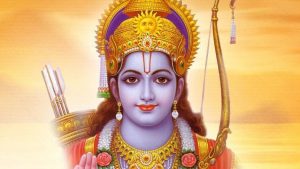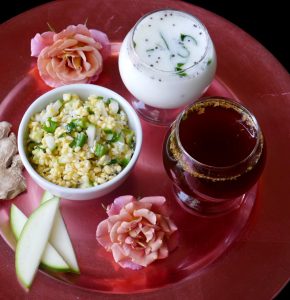Celebrate the Harvest
 Makar Sankranti, the four day harvest festival of India is here and we are ready to express our gratitude to the life giving Sun, the life bearing Earth and the bounty that we have received through them, through the year. Known by different names across the country Pongal, Lohri, Bhogali Bihu, the celebrations are diverse and specific to each region. The Sun moves into the Makar rasi or Capricorn constellation marking the end of winter and Dakshinayana and the start of spring and Uttarayana, the auspicious period. Devotees take a dip in the holy rivers. Homes are stocked with newly reaped harvest and hearts are overflowing with thanks, joy and gratitude.
Makar Sankranti, the four day harvest festival of India is here and we are ready to express our gratitude to the life giving Sun, the life bearing Earth and the bounty that we have received through them, through the year. Known by different names across the country Pongal, Lohri, Bhogali Bihu, the celebrations are diverse and specific to each region. The Sun moves into the Makar rasi or Capricorn constellation marking the end of winter and Dakshinayana and the start of spring and Uttarayana, the auspicious period. Devotees take a dip in the holy rivers. Homes are stocked with newly reaped harvest and hearts are overflowing with thanks, joy and gratitude.
With more than half the population of the country engaged in agriculture and allied activities, the mood of celebration grips the entire nation. Preparations begin weeks in advance. City dwellers book their tickets in advance for a trip to the hometown because they know the last minute surge pricing will burn a hole in their pockets. Those who haven’t been able to go back hometowns take to rooftops and playgrounds armed with colourful kites because the breeze is inviting and the sun is nice and warm. 
In every village, farmers clean and paint their homes. Old stuff is taken out and made a bonfire of, on Bhogi the first day of the festival. People dance and sing around the bonfire to keep the last of the biting cold away. In a run up to the festival the front yard is given a cow dung water wash every morning. Rice flour kolams and colourful rangavallis decorate every threshold in the South.
‘Haridasu’ sing out their stories. ‘Gangireddu, the decorated bull who is seen as ‘Nandishwara’ dances to drum beats and music in every street. This is an ancient art form of entertainment that brings the community together. Recreational animal sports like cock fighting, jallikattu, kambala are looked forward to. On the third day of Kanumu, the ancestors are remembered and blessings sought from elders.
 Women get busy making snacks like palli laddu, sakkinalu and muruku in the South. In the North they make gajak, a popular snack. In the South, cooking Pongal in a mudpot with milk and new rice is an age old tradition. As the milk boils over, everyone calls out ‘Pongalo pongal’ to usher in prosperity into their homes.
Women get busy making snacks like palli laddu, sakkinalu and muruku in the South. In the North they make gajak, a popular snack. In the South, cooking Pongal in a mudpot with milk and new rice is an age old tradition. As the milk boils over, everyone calls out ‘Pongalo pongal’ to usher in prosperity into their homes.
Try out these traditional recipes and relish during Sankranti. In keeping with the spirit of gratitude to mother earth, we recommend that you choose organic and locally sourced ingredients, pour out all your love and gratitude in the making of these dishes. Nothing describes celebration more than a delicious and nourishing meal.
Ven Pongal (Also called the Savory Pongal):
Ingredients:
- 1/2 cup rice
- 1/2 cup split moong dal
- Salt to taste
For Seasoning:
- 2 tbsps ghee
- 1/2 tsp cumin seeds
- 1 inch piece of ginger
- 1 tsp black pepper, coarsely pounded
- 2 tsps cashew nuts pieces
- 1 sprig curry leaves
Preparation:
Wash the moong dal and rice and keep aside. In a pot, add a little ghee and roast the dal till the raw flavour disappears. Add five cups of water and some salt. Cook till soft. Mash the dal rice mix well with a ladle. The consistency should be somewhat loose. In a seasoning ladle, take some ghee, add cashew nut and fry till golden brown. Remove and keep aside. In the same ladle, add cumin seeds, grated ginger and curry leaves. When it is spluttering, add to the pongal and stir well. Garnish with fried cashew nuts and serve hot with coconut chutney.
Sweet Pongal:

Ingredients:
- 1 cup rice
- 1/4 cup chana dal
- 1-1/2 cup jaggery
- 2 cups milk
- 2 cups water
For Seasoning:
- 2 tbsps ghee
- Raisins, cashews, almonds, cardamom
Preparation:
Roast the rice and chana dal separately just till they are hot, not brown. Now boil the milk and water. Once the milk starts bubbling, add the roasted rice and dal and let them cook. In a separate pan, melt the jaggery in half a cup of water till it reaches one string consistency. When the rice and dal are cooked to a porridge like consistency, add this jaggery mixture and switch off the stove. Do not light the stove and cook once you add the jaggery mixture, as the pongal will curdle. (Jaggery and milk when cooked, curdle). Mix all the contents in your vessel, till they blend. In a seasoning spoon, add ghee. Once it melts, add the cashews,almonds, raisins and elaichi. Add this seasoning to the prepared Pongal and serve hot.
You can buy organic ingredients listed in the above recipes from Amazon or BigBasket
Sujata C
Recipes by Bhuvana









